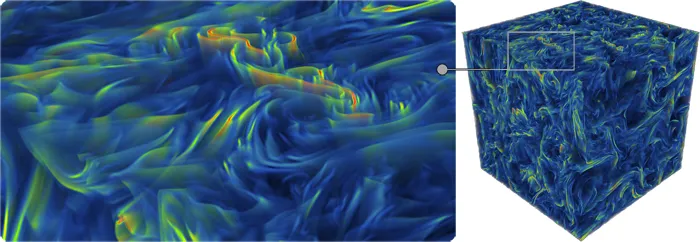Flux-freezing breakdown observed in high-conductivity magnetohydrodynamic turbulence
Gregory Eyink1,2,3,5, Ethan Vishniac6, Cristian Lalescu1, Hussein Aluie1,7, Kalin Kanov4, Kai Bürger8, Randal Burns4,5, Charles Meneveau3,5, Alexander Szalay2,5
1 Department of Applied Mathematics & Statistics, The Johns Hopkins University, Baltimore, MD, 21218, USA.
2 Department of Physics & Astronomy, The Johns Hopkins University, Baltimore, MD, 21218, USA.
3 Department of Mechanical Engineering, The Johns Hopkins University, Baltimore, MD, 21218, USA.
4 Department of Computer Science, The Johns Hopkins University, Baltimore, MD, 21218, USA.
5 Institute for Data Intensive Engineering & Science, The Johns Hopkins University, Baltimore, MD, 21218, USA.
6 Department of Physics and Engineering Physics, University of Saskatchewan, Saskatoon, SK S7N 5E2, Canada.
7 Los Alamos National Laboratory, T-Division and Center for Nonlinear Studies, Los Alamos, NM, 87545, USA.
8 Fakultät für Informatik, Technische Universität München, Munich, Germany.

Abstract
The idea of ‘frozen-in’ magnetic field lines for ideal plasmas is useful to explain diverse astrophysical phenomena, for example the shedding of excess angular momentum from protostars by twisting of field lines frozen into the interstellar medium. Frozen-in field lines, however, preclude the rapid changes in magnetic topology observed at high conductivities, as in solar flares. Microphysical plasma processes are a proposed explanation of the observed high rates, but it is an open question whether such processes can rapidly reconnect astrophysical flux structures much greater in extent than several thousand ion gyroradii. An alternative explanation is that turbulent Richardson advection brings field lines implosively together from distances far apart to separations of the order of gyroradii. Here we report an analysis of a simulation of magnetohydrodynamic turbulence at high conductivity that exhibits Richardson dispersion. This effect of advection in rough velocity fields, which appear non-differentiable in space, leads to line motions that are completely indeterministic or ‘spontaneously stochastic’, as predicted in analytical studies. The turbulent breakdown of standard flux freezing at scales greater than the ion gyroradius can explain fast reconnection of very large-scale flux structures, both observed (solar flares and coronal mass ejections) and predicted (the inner heliosheath, accretion disks, γ-ray bursts and so on). For laminar plasma flows with smooth velocity fields or for low turbulence intensity, stochastic flux freezing reduces to the usual frozen-in condition.
Associated publications
Flux-freezing breakdown observed in high-conductivity magnetohydrodynamic turbulence
G. Eyink, E. Vishniac, C. Lalescu, H. Aluie, K Kanov, K. Bürger, R. Burns, C. Meneveau and A. Szalay,
Nature 497, 466–469, (23 May 2013), doi:10.1038/nature12128